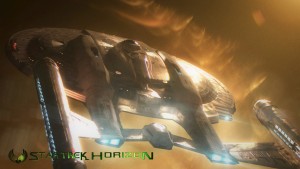 Last time: we got our first look at the newest Star Trek fan film to take the online world by storm, Star Trek: Horizon. Since it debuted online seven days ago, it’s logged well over 300,000 views on YouTube! If you haven’t watched it yet, click that link in the opening sentence and do it. Do it NOW!!! (Imagine Arnold Schwarzenegger’s voice saying that.)
Last time: we got our first look at the newest Star Trek fan film to take the online world by storm, Star Trek: Horizon. Since it debuted online seven days ago, it’s logged well over 300,000 views on YouTube! If you haven’t watched it yet, click that link in the opening sentence and do it. Do it NOW!!! (Imagine Arnold Schwarzenegger’s voice saying that.)
Seriously, though, this fan film is amazing, made even more so by the simple fact that it was filmed almost entirely in a basement against a green screen! It features trained actors, cutting edge quality visual effects, and an original composed musical score. Add to that a compelling story, engaging characters, solid directing, and top-notch editing…and you’ve got a MUST SEE fan film that both dazzles and delights. (Yeah, I kinda liked it.)
Star Trek: Horizon is also notable for being one of the only Star Trek fan films to be based in the 22nd century era of Star Trek: Enterprise…a particularly challenging time period to depict because of the complex jumpsuit uniforms and the elaborate sets. But believe it not, just one person hand-sewed all his uniforms himself to exacting standards and created all of the virtual 3D sets that were used to composite behind the green screen filmed actors. This same person wrote the script, lighted and directed all the actors, did the visual effects, edited together the entire 102-minute film, and even composed the musical score. Yep, one guy did all of that!
This “Renaissance Man” of fan films is none other than Tommy Kraft of Jackson, Michigan. A recent graduate of college with a degree in music, Tommy’s true passion is to direct films. And that has led him on a path that has taken him into the realm of Star Trek and will likely continue well beyond.
Last week, we learned a little about how Tommy got from there to here, why he chose the NX-01 Enterprise-era, and what went into writing his script and prepping for production. We conclude our interview with a look at the production process itself, postproduction, and where Tommy plans to go from here…
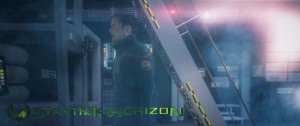 JONATHAN: So you’ve got a script, you’ve got virtual sets, and you’ve got costumes. Now you just need people to fill them. You live in south central Michigan, 80 miles from Detroit…not necessarily the acting capital of the world. How did you find real, trained actors to play your characters?
JONATHAN: So you’ve got a script, you’ve got virtual sets, and you’ve got costumes. Now you just need people to fill them. You live in south central Michigan, 80 miles from Detroit…not necessarily the acting capital of the world. How did you find real, trained actors to play your characters?
TOMMY: I asked people to drive in from Detroit! That was really the gist of it, and also why the film took over a year to shoot. Actors were coming in to shoot when they had free time and no one was paid on the film, so it was a really long and trying process. But we were able to do it.
JONATHAN: Can you tell us a little about your main actors? What are their backgrounds? Are any of them Star Trek fans, too?

TOMMY: Most of them work in the Michigan area part time as actors while either pursuing acting as a career or as a side job. The only actor on the film that was really a big Star Trek fan coming in was Ryan Webber. He plays Commander Francis Brookes, Discovery’s chief engineer. He actually created a series of fan films himself when he was in high school over fifteen years ago! For anyone in the know, they were the Encarta fan films. I posted a casting call on the Michigan Film Office website, and when he saw that there was a fan film shooting in Michigan, he said he had to get involved. So he contacted me and auditioned. He not only did a great job on his audition, but we immediately hit it off as fellow Trekkies and became great friends!
Working with Paul Lang (Captain Hawke) was a tremendous amount of fun. He’s such a nice guy and always funny on set, which makes for a nice time but also means I had to learn how to corral actors when they start telling a lot of jokes! I love Paul, though.
Everyone on the film was great. I have a wonderful sarcastic relationship with Marc Bowers (Commander Jackson Gates), which is really apparent in our blooper reel. On top of that he had a great analytical approach to the character and performance, which worked so well.
Tom McClure (Lieutenant Tom Samuels) was tremendous as our tactical officer, who also happens to be named Tom! He brought a great passion to the character, and the role that really makes the audience believe that this guy loves what he does, and he’s just a nice guy!
Ashley Croft (Ensign Marie Sutherland) was so professional (that’s not to say the others weren’t) but she came in every day with her lines down, and we never had to do more than a couple takes with her. She knew her stuff and was nice to work with.
I can’t say enough about Callie Bussell (Lieutenant T’mar). I’ve known her the longest of anyone in the cast. We went to college together and have been friends for six plus years. I actually wrote the role of T’mar with her in mind, and she knocked it out of the park. I’ve worked with her on many projects now and I’m sure I will continue to work with her in the future.
To round out our bridge crew, Jeannine Thompson (Lieutenant Amelia Yarris) brought a great quality to her character, and I was honestly quite surprised at how great performance was. That’s not to say I ever expected her to be bad, but she just brought such a realism to that character and made you really care for her and her struggle with the competing priorities of her mission and her feelings for Hawke.
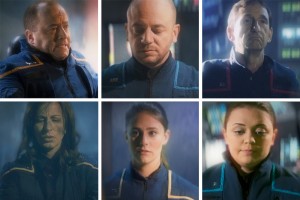
JONATHAN: Now, I know I billed you as the jack-of-all-trades who made this film almost single-handedly, but the fact is that, in addition to your many actors, you also had two dozen or so other folks doing some very important things for this film. Here’s your chance to spotlight some of them…
TOMMY: Absolutely! I have to name Eric Henry; he did so much great concept art for Horizon, and we worked very closely. He would sometimes draw a piece and I’d model it, or he would model it and I’d texture it, or we’d kind-of co-model something. He was invaluable on this project. Some other great people include Alexander Klemm who created our three Vulcan ship models, Ryan McClure who created our Romulan Bird of Prey, Adge Cutler who let me use his Enterprise-era LCARS graphics, and even Ryan Webber (my chief engineer) who did a lot of rotoscoping work for me. One final huge name I have thank is Michael Huang. This guy appeared out of nowhere and did the sound design, mix, and master for the whole film for free. He’s a professional guy with a studio and just wanted to help out, and he did such a great job. He took the film to the next level and really made it sound like a big movie. Beyond that, there were a lot of people who contributed things here and there, and I couldn’t be more thankful for that.
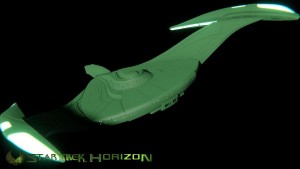
JONATHAN: How long did live-action filming take in total, and when did you shoot it…all at the same time or in segments? Was it a fun romp or a boatload of work…or both?
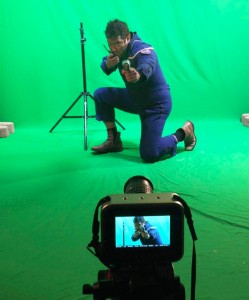
TOMMY: It was both fun and very draining. It was a lot of work, and was never easy. We shot the film over the course of about a year and had a total of around 18 shooting days. Due to the fact that actors could only come when their schedules were free, we were forced to shoot a vast majority of our scenes one person at a time. The green screen afforded us this opportunity, but it’s certainly not ideal from a filmmaking and acting standpoint. But we did what we had to do and made it work in the end.
JONATHAN: In mid-2014, you held a Kickstarter campaign with a goal of $10,000. After 30 days, you more than doubled that with $22,600. You also took in direct Paypal donations. All in all, how much money did you generate from backers? And what was that money used for?
TOMMY: We generated around $40,000 from backers. The money went to many things, but some of the key items included upgrading computers and storage so I could render shots faster and actually keep all of our footage, purchasing new software for various effects purposes (such as PF Track and Terragen, among others), purchasing new gear such as better lighting for the green screen work, food for cast and crew, etc. etc.
JONATHAN: So once all the raw footage was shot, it still took more than a year to complete the film. I say the following totally tongue-in-cheek: what took ya so long, dude???
TOMMY: Well, as they say, Romulus wasn’t built in a day! It really was just a tremendous amount of compositing and visual effects work that took a long, long time to get finished.
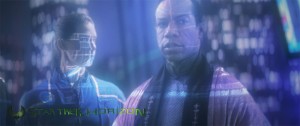 JONATHAN: As I mentioned in my introduction last week, it was a bold decision by you, as director, to make the stylistic choices that you did, such as shaky camera moves, blurry backgrounds, stark lighting, and those infamous lens flares (not nearly as many as JJ, though!). Now, I’m assuming you could also have made this film look like more traditional Star Trek, right? So why push the envelope so far away from fans’ comfort zones?
JONATHAN: As I mentioned in my introduction last week, it was a bold decision by you, as director, to make the stylistic choices that you did, such as shaky camera moves, blurry backgrounds, stark lighting, and those infamous lens flares (not nearly as many as JJ, though!). Now, I’m assuming you could also have made this film look like more traditional Star Trek, right? So why push the envelope so far away from fans’ comfort zones?
TOMMY: It’s really more because it’s the look I wanted for the film. And it’s a look that kind of developed organically over the long course of me doing all that compositing work. Some of it was developed out of necessity to help try and hide the digital nature of the film as much as possible, some of it was from experimentation, and some of it was just looks that I liked. When it comes to blurry backgrounds, this is an effect that simply mimics real world lenses and cameras. Depending on the lens and camera choices you have, you can get really blurry backgrounds or really sharp backgrounds. The nutshell version of it is what someone else said to me about the film: “This isn’t Enterprise does Tommy Kraft, it’s Tommy Kraft does Enterprise.” It’s my take on a show I love; I never intended to completely mimic it because I wanted to create something original.
JONATHAN: Now, I don’t know much about music, but the score you composed for Horizon sounds like you were channeling your inner Bear McCreary (from the new Battlestar Galactica). Personally, I love the soundtrack, but again, it’s very different from what Trek fans are used to. What was your thought process as you composed your score for Horizon?
TOMMY: My inner Bear McCreary just comes out without me trying. I love his music, and it has long been an inspiration of mine. I’d like to think that Hans Zimmer, Jerry Goldsmith, Brian Tyler, and others come through at certain times too. I’m a huge fan of their music. But, like with the visuals, I wanted to create a score that I liked and felt fit the tone of the film. I didn’t want to attempt to mimic what McCarthy, Goldsmith, Chattaway, and others have done on Star Trek. I wanted to bring my own style to it.
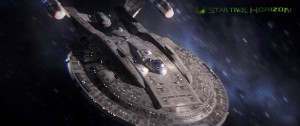 JONATHAN: So now that you’ve got Horizon notched in your belt, will you be chronicling any more 22nd century Star Trek…or even 23rd or 24th century adventures of other crews?
JONATHAN: So now that you’ve got Horizon notched in your belt, will you be chronicling any more 22nd century Star Trek…or even 23rd or 24th century adventures of other crews?
TOMMY: If I had unlimited time and money, I would. The problem is, as a filmmaker who wants to pursue a career in this field, there’s not much upward mobility left in fan films after I finish Horizon. The genre can’t take my career to the next level, as it were, so for my following projects, I’m going to return to original stories and scripts.
JONATHAN: And finally, after three years of your life spent on this project, what have you learned?
TOMMY: I’ve learned so much that it’s hard to put it all into words, to be honest. I’ve expanded the depth of my filmmaking knowledge in ways I never expected possible. I filled so many positions on this film and put so much effort into learning how to do them that now I know, when I work on a larger project with a full crew, what I will be asking them to do. When I go to a costume designer, I know exactly what I’m asking that person for because I’ve made a lot of costumes myself. When I go to a visual effects artist, I know what I’m asking of that person because I’ve done so much myself. Just really getting into the process of every area of filmmaking has been a huge boon to my career. Beyond that, I learned a lot about what’s important when it comes to time management. That is to say I learned how best to capitalize on the time and money I have to make the most of what I have to work with.
All in all, Horizon has been a tremendous experience that I wouldn’t trade for the world.
And in case you missed it, here’s a link to Star Trek: Horizon.
And here’s a link to their blooper reel.
(NOTE: there’s some swear words in there that you might not want your cadets to hear.)
